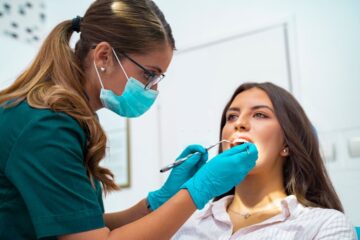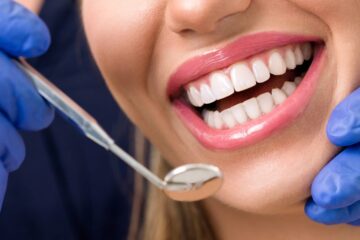Brace yourself for a revolution in orthodontic care that goes beyond the traditional metal wires and brackets. Welcome to a world where innovation meets precision, and where braces and aligners are just the beginning of a new era in dental treatment.
In this article, we will take you on a journey through the latest advancements that are reshaping orthodontics as we know it.
Imagine a smile transformed without anyone knowing, like a hidden treasure waiting to be discovered. Clear aligners have emerged as a discreet alternative to traditional braces, allowing you to straighten your teeth with confidence. But that’s not all.
Self-ligating braces bring enhanced efficiency and comfort to your orthodontic experience, while lingual braces offer invisible treatment from within.
Time is of the essence, and accelerated orthodontics aims to shorten your treatment time without compromising quality. And let’s not forget about digital technology, which brings precision and predictability to every step of your orthodontic journey.
Get ready to explore these ground-breaking innovations that are revolutionizing orthodontic care. Brace yourself for an exciting future where braces, aligners, and beyond await you.
Clear Aligners: A Discreet Alternative to Traditional Braces
Clear aligners are a fantastic option for those seeking a more discreet and convenient alternative to traditional braces. These invisible aligners provide an effective solution for orthodontic treatment while being virtually unnoticeable. Made from clear orthodontic appliances, clear aligners are custom-made to fit snugly over your teeth, gradually moving them into the desired position.
One of the key advantages of clear aligners is their transparency. Unlike traditional braces with metal brackets and wires, these aligners are virtually invisible when worn. This makes them a popular choice among adults who want to straighten their teeth without drawing unnecessary attention.
Additionally, clear aligners offer greater convenience compared to traditional braces. They’re removable, allowing you to eat and drink without any restrictions. You can also brush and floss your teeth easily since there are no wires or brackets in the way. This not only ensures better oral hygiene but also leads to improved overall dental health.
Transitioning into the subsequent section about self-ligating braces, it’s important to note that while clear aligners have their benefits, they may not be suitable for everyone. If you’re looking for an alternative treatment option that offers enhanced efficiency and comfort, self-ligating braces might be worth considering.
Self-Ligating Braces: Enhanced Efficiency and Comfort
With self-ligating braces, it’s like a smooth glide on a roller coaster for your teeth, enhancing efficiency and comfort. These innovative braces use a special bracket system that eliminates the need for elastic or metal ties to hold the arch wire in place. Instead, the brackets have built-in clips that securely hold the wire, allowing for greater control and reduced friction during treatment.
One of the main advantages of self-ligating braces is their enhanced aesthetics. Unlike traditional braces with visible elastics, self-ligating braces have a more discreet appearance. The brackets are smaller and sleeker, making them less noticeable when you smile or speak. This can be especially beneficial for individuals who are concerned about their appearance during orthodontic treatment.
In addition to improved aesthetics, self-ligating braces also offer reduced treatment time compared to traditional braces. The advanced design of these braces allows for faster tooth movement and fewer adjustments during each visit to your orthodontist. This means that you may achieve your desired results in less time than with other orthodontic treatments.
Transitioning into the subsequent section about lingual braces: invisible treatment on the inside, these hidden braces provide an alternative option for those seeking even greater discretion in their orthodontic journey.
Lingual Braces: Invisible Treatment on the Inside
Imagine a treatment option that allows you to straighten your teeth without anyone knowing – lingual braces are the hidden secret to achieving a perfect smile. Unlike traditional braces that are placed on the front of your teeth, invisible lingual braces are attached to the back of your teeth, making them virtually undetectable. This makes them an excellent choice for individuals who want a discreet orthodontic treatment option.
Lingual braces offer several advantages over clear aligners. While both options provide effective tooth movement, lingual braces can treat more complex cases that aligners may not be able to handle. Additionally, unlike aligners which need to be removed during meals and oral hygiene routines, lingual braces stay in place 24/7. This means there is no risk of misplacing or losing them.
With invisible lingual braces, you can confidently go about your day-to-day activities without feeling self-conscious about wearing orthodontic appliances. People will never know that you are undergoing treatment unless you choose to tell them.
Now let’s move on to the next section which discusses accelerated orthodontics and how it can help shorten treatment time.
Accelerated Orthodontics: Shortening Treatment Time
Accelerated orthodontics can significantly reduce the time it takes to complete your treatment. With the latest orthodontic advancements, such as invisible aligners and other innovative techniques, orthodontists are now able to expedite the teeth straightening process.
In traditional orthodontic treatment, it can take several years before you see the desired results. However, accelerated orthodontics uses cutting-edge methods that aim to speed up this timeline. By applying greater forces on your teeth or using devices that stimulate bone remodelling, your treatment time can be reduced by months or even years.
One popular method of accelerated orthodontics is through the use of invisible aligners. These clear plastic trays gradually move your teeth into their desired positions over a shorter period compared to traditional braces. Not only are these aligners virtually invisible, but they also offer more convenience and comfort during your treatment.
By incorporating digital technology in orthodontics, precision and predictability have greatly improved. This allows for more accurate planning and monitoring of your treatment progress. In our next section about digital technology in orthodontics: precision and predictability, we will explore how these advancements have revolutionised the field of orthodontics.
Transitioning seamlessly into our next topic, let’s delve into how digital technology has enhanced precision and predictability in orthodontic care without skipping a beat.
Digital Technology in Orthodontics: Precision and Predictability
Thanks to advancements in digital technology, orthodontic treatment has become more precise and predictable, revolutionising the way patients achieve their desired results. Precision technology and digital advancements have significantly improved the accuracy of orthodontic diagnosis and treatment planning, leading to better outcomes for patients.
Digital imaging techniques, such as cone-beam computed tomography (CBCT), allow orthodontists to obtain detailed three-dimensional images of a patient’s teeth and jaws. This enables them to accurately assess the alignment of teeth, identify any underlying issues, and develop a customised treatment plan. The use of digital models also eliminates the need for messy impressions, providing a more comfortable experience for patients.
In addition to improved diagnostics, digital technology has also transformed the way braces are designed and manufactured. Computer-aided design (CAD) software allows orthodontists to create virtual models of patients’ teeth and simulate different treatment options. These models can then be used to fabricate custom-made braces or aligners using 3D printing technology. This level of precision ensures that appliances fit perfectly on each individual tooth, maximising comfort and effectiveness.
Furthermore, digital monitoring systems now exist that allow orthodontists to track the progress of treatment remotely. Patients can take regular scans or photos at home using smartphone apps or handheld devices, which are then analysed by their orthodontist. This not only reduces the frequency of in-office visits but also provides real-time feedback on how well the treatment is progressing.
Precision technology and digital advancements have revolutionised orthodontic care by improving diagnostic accuracy, enabling personalised treatment plans with custom-made appliances, and providing remote monitoring capabilities. Thanks to these innovations, patients can now achieve their desired results more predictably than ever before.
Frequently Asked Questions
How much do clear aligners cost compared to traditional braces?
Clear aligners, like Invisalign, generally cost more than traditional braces. However, the benefits of clear aligners, such as their discreet appearance and removable nature, make them a popular choice for adults seeking orthodontic treatment.
Can self-ligating braces be used for all types of orthodontic cases?
Self-ligating braces are effective for most orthodontic cases. They offer benefits such as faster treatment time, reduced discomfort, and easier brushing. Their design allows for better control and adjustments during the treatment process.
What is the average treatment time for lingual braces?
The average treatment duration for lingual braces is typically around 18-36 months. However, it’s important to note that this can vary depending on the complexity of the case and individual factors. Additionally, lingual braces tend to have a higher cost compared to traditional braces.
Are there any risks or side effects associated with accelerated orthodontics?
Accelerated orthodontics, while innovative, may have some risks and side effects. It’s important to be aware that the process of speeding up treatment can lead to increased discomfort, root resorption, and potential damage to teeth or gums.
How does digital technology improve the accuracy of orthodontic treatments?
Digital technology in orthodontic treatments is like having a superhero sidekick. It enhances accuracy, allowing precise measurements and treatment planning. The benefits include faster results, improved patient comfort, and better communication between orthodontists and patients.
Conclusion
So there you have it, a comprehensive look at the latest innovations in orthodontic care.
From clear aligners to self-ligating braces and lingual braces, these advancements offer patients discreet and comfortable treatment options.
And with accelerated orthodontics and digital technology, the time spent wearing braces can be significantly reduced while ensuring precise and predictable results.
It’s like stepping into a new era of orthodontic care, where efficiency meets precision and where smiles are transformed with ease.
Orthodontics has truly come a long way!





